Photographs: Reuters. BS Reporters in Bangalore/Chennai/Kolkata
The prices of agricultural commodities have jumped by up to 300 per cent from the wholesale market to consumers' tables due to short supply.
Normally, the difference goes up to 300 per cent only in abnormal circumstances. Apart from the delayed monsoon, massive wastage in transit and involvement of a series of middlemen, obviously for making profit at every layer, are resulting in such prices.
Our team's physical checks in wholesale and retail markets reveal that among larger metropolitan cities, the price difference in Mumbai is the highest, followed by New Delhi.
...
Why prices rise by 300% from wholesale market to consumers
Photographs: Reuters.
These are as high as 200-300 per cent in most vegetables and grains and pulses. In other metros, prices are higher by 50-100 per cent from wholesale to retail.
Organised retail chains are no different. In most organised stores, prices have been found near those prevailing in retail markets. In Mumbai, most commodities come from outside, it being an island city.
<B>Why</B><BR>
Rapidly perishable essential commodities like vegetables involve high risk in handling and transportation. Hence, their cost of carry remains always higher.
Also, handling of such commodities, especially in transit and wastage, thereupon, is abnormally high. Consequently, inflation in these is felt only in retail outlets, despite a very normal price in wholesale mandis. Farmers get around 50 per cent of the wholesale price.
...
Why prices rise by 300% from wholesale market to consumers
Photographs: Reuters.
Since it is impossible to visit mandis for common consumers and pick commodities in bulk (vegetables are not sold in a quantity below five kg and grains in less than a quintal in Navi Mumbai's Vashi mandi, for instance), due to the threat of spoilage, they collect vegetables in relatively small quantities (0.25 - 0.5 kg average sales) from grocery-retailers in the vicinity.
According to Avinash Patil, deputy secretary, Agricultural Produce Marketing Committee (APMC), Vashi, the price for retail consumers works out higher due to factors other than the wholesale price.
...
Why prices rise by 300% from wholesale market to consumers
Image: A farmer and his family work at their cauliflower field amid dense fog.Photographs: Ajay Verma/Reuters.
He says retailers suffer a loss of nearly 30 per cent in the weight of rapidly perishable vegetables like cabbage, cauliflower and tomatoes, due to poor handling and spoilage.
To keep these looking fresh, retailers generally polish each piece of tomato and chop the outer leaves of cabbages and cauliflowers.
Also, prices of every commodity for retailers are determined by the quantity of procurement and the area of sales. For example, in posh areas, the retail price of every commodity is quoted higher compared to a middle class locality.
...
Why prices rise by 300% from wholesale market to consumers
Image: Workers spread red chilli peppers to dry in Shertha village on the outskirts of Ahmedabad.Photographs: Amit Dave/Reuters.
Other factors
Usmanbhai Syed, president, Wholesale Vegetable Marchants' Association, Vashi, however, feels retailers generally factor in unavoidable additional expenses, including mandi tax, transportation charges from the wholesale to the retail market and labour cost, for arriving at the retail price.
Roadside hawkers of vegetables have to factor in unofficial expenses as well.
For coarse cereals and other bulk consumables, transportation and labour cost hardly matter, due to the large quantity of purchase. For consumers, however, the price of coarse cereals, sugar and pulses rises at least 50 per cent.
...
Why prices rise by 300% from wholesale market to consumers
Photographs: Reuters.
Future Group buys onions from Nashik and potatoes from Agra mandis for its stores. If onion costs Rs 2 in Nashik, by the time it reaches stores in Mumbai, the price becomes Rs 14.
"There are all kinds of people involved. There are farmers, intermediaries, mandi, next mandi, APMC, through whom the commodities pass. Then, there is transportation and wastage," says a Future group executive.
According to a Boston Consulting Group study in 2011, the supply chain of vegetables such as tomatoes has five levels between farmers in Narayangaon in Maharashtra (known for tomato cultivation), the APMC yard in Vashi in Navi Mumbai and the end-consumers in Mumbai.
...
Why prices rise by 300% from wholesale market to consumers
Image: A farmer sits besides a heap of paddy as he protects himself with plastic tarpaulin during rains.Photographs: Ajay Verma/Reuters.
The chain involves a farmer, aggregator, market trader, wholesaler, sub-wholesaler and retailer, before the vegetable reaches the end-consumer.
In the process, 30 per cent is farmer realisation, 24 per cent is value addition such as sorting and grading, 23 per cent is leakages and another 23 per cent is gross profit.
"Brokers buy at cheap rates and sell at a high price. They do not allow demand and supply factors to determine prices," the Future Group executive said.
...
Why prices rise by 300% from wholesale market to consumers
Image: An Indian farmer sleeps on watermelons in Siliguri.Photographs: Rupak De Chowduri/Reuters.
Explaining the rationale for high pricing, another retail executive of a hypermarket chain says a farmer sells a cabbage for Rs 1 or Rs 1.50 to a local broker, who sells it at Rs 7-8 to a mandi broker, who sells it at Rs 16-17 to the retailer, who sells it to the final consumer at Rs 20.
"We buy tomatoes from Vashi APMC. Per cart we pay about Rs 28 for transportation, we also keep a margin of almost 50 per cent, in addition to the prevalent mandi tax. These levies make commodities costlier for retail consumers," said Sajid Ansari, a Mumbai-based retailer.



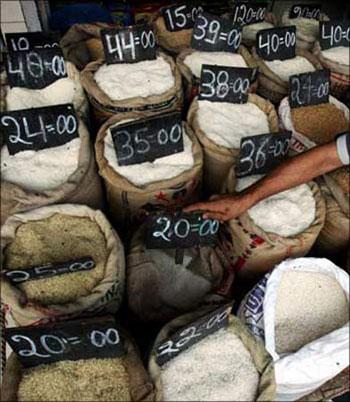
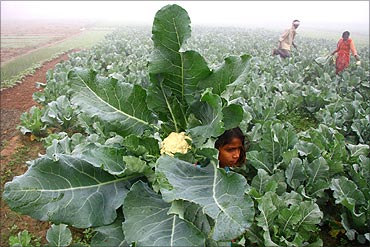
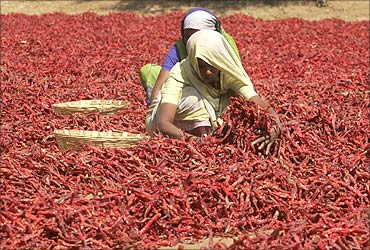

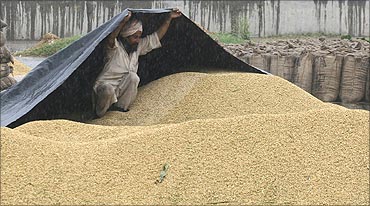
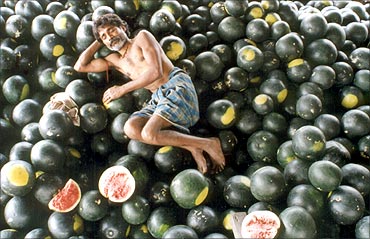

article